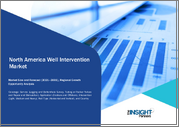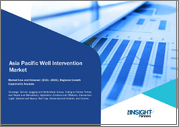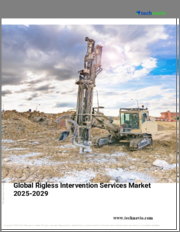
|
시장보고서
상품코드
1806238
갱정 개재 시장 : 인터벤션 유형, 서비스 유형, 갱정 유형, 용도별 - 세계 예측(2025-2030년)Well Intervention Market by Intervention Type, Service Type, Well Type, Application - Global Forecast 2025-2030 |
||||||
갱정 개재 시장은 2024년에는 85억 6,000만 달러로 평가되었습니다. 2025년에는 90억 1,000만 달러에 이르고, CAGR 5.47%로 성장하여 2030년에는 118억 달러에 달할 것으로 예측됩니다.
| 주요 시장 통계 | |
|---|---|
| 기준 연도 : 2024년 | 85억 6,000만 달러 |
| 추정 연도 : 2025년 | 90억 1,000만 달러 |
| 예측 연도 : 2030년 | 118억 달러 |
| CAGR(%) | 5.47% |
현대 유정 시추 수요와 작업 우선순위가 어떻게 계획, 조달 및 자산 무결성 전략을 재구성하고 있는지에 대한 결정적인 관점
성숙한 유전의 생산을 유지하고 기술적으로 어려운 유전층에서 가치를 창출해야 한다는 두 가지 압력에 힘 입어 유정 개입 상황이 점점 더 복잡해지고 있습니다. 현재 운영자는 장기적인 건전성 문제에 대한 위험을 줄이는 동시에 개입 전략을 통해 즉각적인 가동 시간 개선을 기대할 수 있습니다. 이를 위해서는 운영상의 제약, 진화하는 서비스 능력, 지하 상태와 지표면 물류와의 상호 작용에 대한 미묘한 이해가 필요합니다.
디지털 진단, 성과 지향적 계약, 라이프사이클 무결성 통합이 개입 전략과 상업적 무결성을 근본적으로 재정의하는 방식
지난 5년 동안 기술적 성숙에서 상업적 모델의 진화까지, 기업이 유정 개입에 접근하는 방식을 재구성하는 변혁적 변화가 일어났습니다. 디지털 진단과 실시간 갱내 텔레메트리는 파일럿 프로젝트에서 운영으로 전환하여 상태에 따른 개입과 보다 정확한 근본 원인 분석을 가능하게 했습니다. 이러한 진화를 통해 개입 조치의 범위가 넓어지고, 팀은 광범위하고 비용이 많이 드는 캠페인이 아닌 생산 비효율성을 외과적 정밀도로 타겟팅할 수 있게 되었습니다.
관세 조정별, 개입 장비 및 서비스 공급망, 조달 탄력성, 업무 경제성이 어떻게 재구성되는지 이해합니다.
최근 주요 수입국의 관세 조정에 대한 정책 동향은 유정 시추 개입 장비 및 소모품에 새로운 비용과 공급망 역학을 도입하고 있습니다. 관세 변경은 특수 공구, 광산 내 전자 장비, 특정 금속 부품의 상륙 비용을 상승시킬 수 있으며, 그 결과 구매 전략과 재고 정책에 영향을 미칠 수 있습니다. 사업자와 서비스 제공업체는 조달 발자국을 재평가하고, 현지 조달 이니셔티브를 가속화하며, 공급망 탄력성을 강조함으로써 대응하고 있습니다.
개입 유형, 서비스군, 유정 환경, 용도에 특화된 워크플로우 등 세분화를 통해 업무 우선순위를 명확히 하는 실용적인 인사이트 제공
세분화 인사이트는 개입 유형, 서비스 유형, 우물 유형, 용도의 렌즈를 통해 조사함으로써 개입 서비스 제공 전반에 걸쳐 미묘한 수요 동인과 서비스 우선순위를 파악할 수 있습니다. 유정 유형에 따른 차별화를 살펴보면, 중작업 유정에 대한 개입은 복잡한 동원 및 중량물 운반이 필요한 대규모 작업 캠페인이 우선시되는 반면, 경작업 유정에 대한 개입은 신속한 대응과 적은 동원이 필요한 작업에 중점을 둔다는 점이 부각되었습니다.
미주, 중동/아프리카, 아시아태평양의 각 지역의 원동력이 개입 전술, 역량 요구, 공급망 전략을 어떻게 형성하고 있는가?
지역적 원동력은 개입 접근법, 상업적 합의, 기술 우선순위에 중대한 영향을 미치며, 이러한 차이는 전략 계획에 중요한 영향을 미칩니다. 미국 대륙에서는 성숙한 생산 분지와 활발한 셰일층이 결합되어 특히 자극, 인공 리프트 최적화 및 모래 제어 기술에 중점을 둔 신속하고 빈번한 개입에 대한 수요가 증가하고 있습니다. 규제 프레임워크와 현지 서비스 제공업체에 대한 접근성이 계약 선호도를 형성하고 있으며, 다양한 육상 자산에 배치할 수 있는 모듈식 및 운송 가능한 시스템에 대한 의지가 두드러집니다.
역량, 지역 확장, 통합 솔루션 제공에서 차별화를 주도하는 서비스 제공업체 간의 주요 전략적 속성 및 파트너십 모델
개입 생태계에 참여하는 기업들은 엔지니어링의 깊이, 지역적 발자취, 서비스 통합에 있어 차별화된 강점을 보이고 있습니다. 주요 기술 및 서비스 기업들은 디지털 진단, 모듈화된 도구, 상호 훈련된 인력에 대한 투자를 늘리고, 운영자의 운영 복잡성을 줄여주는 엔드투엔드 패키지를 제공합니다. 이들 제공업체는 종종 자본 집약적인 자산 역량과 성과 지향적 계약을 결합하여 고객이 소유에 대한 부담 없이 전문 기술을 이용할 수 있도록 합니다.
디지털 역량, 상업적 모델, 공급망 강인성을 유정 개입 목표와 동기화하기 위한 경영진 및 기술 리더를 위한 실행 가능한 단계
업계 리더는 통찰력을 안전, 가동 시간, 비용 효율성의 측정 가능한 개선으로 연결하기 위해 일련의 실용적인 조치를 취해야 합니다. 첫째, 상태 기반 개입을 가능하게 하고 반응적 다운타임을 줄이는 디지털 진단 및 원격 측정에 대한 투자를 우선시합니다. 이를 통해 운영팀은 근본 원인을 조기에 파악하고 보다 정확한 개입을 통해 전체 개입 빈도를 줄이고 생산의 일관성을 향상시킬 수 있습니다.
현장 경험, 기술 문헌, 비교 검증을 통합하여 운영 기반 지식을 얻기 위한 혼합 방법론 조사 접근법
이 조사는 기술적 엄격함과 실용적 타당성의 균형을 맞추기 위해 고안된 혼합법적 접근법을 사용했습니다. 1차 입력에는 숙련된 현장 엔지니어, 개입 감독자, 조달 책임자 및 주제 전문가와의 인터뷰를 통해 운영 과제, 계약 선호도 및 기술 도입 장벽에 대한 직접적인 통찰력을 얻을 수 있습니다. 2차 분석에서는 전문가들의 심사를 거친 기술 문헌, 규제 지침, 일반에 공개된 사례 연구를 검토하고, 업무 내러티브를 검토하여 반복적으로 언급되는 주제를 확인했습니다.
전략적 우선순위를 간결하게 통합하여 통합 진단, 모듈식 설계 및 일관된 계약이 어떻게 개입 활동을 지속적인 자산 성과로 전환할 수 있는지를 보여줍니다.
마지막으로, 진화하는 유정 개입 환경은 기술적 엄격함, 상업적 유연성, 공급망 선견지명을 겸비한 조직에 보상을 제공합니다. 디지털 진단, 모듈화된 장비 설계 및 성과 지향적 계약은 선택적 혁신이 아니라 점점 더 까다로워지는 상황에서 생산량을 유지하고 무결성 리스크를 관리하려는 운영자에게 필수적인 요소입니다. 개입 활동을 라이프사이클 계획 및 지역 공급 전략과 연계함으로써 기업은 불확실성을 줄이고 보다 예측 가능한 자산 성과를 이끌어낼 수 있습니다.
목차
제1장 서문
제2장 조사 방법
제3장 주요 요약
제4장 시장 개요
제5장 시장 역학
제6장 시장 인사이트
- Porter's Five Forces 분석
- PESTEL 분석
제7장 미국 관세의 누적 영향 2025
제8장 갱정 개재 시장 : 인터벤션 유형별
- 헤비 갱정 개재
- 라이트 갱정 개재
- 미디엄 갱정 개재
제9장 갱정 개재 시장 : 서비스 유형별
- 인공 리프트
- 피싱
- 로깅 및 유정 바닥 조사
- 재천공
- 보수 시멘팅
- 사방
- 자극
- 튜브/패커 고장 및 수리
- 구역 분리
제10장 갱정 개재 시장 : 갱정 유형별
- 오프쇼어
- 온쇼어
제11장 갱정 개재 시장 : 용도별
- 장비 수리 및 유지보수
- 생산 증대
- 급수 차단/관리
- 유정 폐기
- 유정 접근 및 모니터링
- 유정 무결성 관리
제12장 아메리카의 갱정 개재 시장
- 미국
- 캐나다
- 멕시코
- 브라질
- 아르헨티나
제13장 유럽, 중동 및 아프리카의 갱정 개재 시장
- 영국
- 독일
- 프랑스
- 러시아
- 이탈리아
- 스페인
- 아랍에미리트(UAE)
- 사우디아라비아
- 남아프리카공화국
- 덴마크
- 네덜란드
- 카타르
- 핀란드
- 스웨덴
- 나이지리아
- 이집트
- 튀르키예
- 이스라엘
- 노르웨이
- 폴란드
- 스위스
제14장 아시아태평양의 갱정 개재 시장
- 중국
- 인도
- 일본
- 호주
- 한국
- 인도네시아
- 태국
- 필리핀
- 말레이시아
- 싱가포르
- 베트남
- 대만
제15장 경쟁 구도
- 시장 점유율 분석, 2024
- FPNV 포지셔닝 매트릭스, 2024
- 경쟁 분석
- Baker Hughes Company
- Weatherford International plc
- Schlumberger Limited
- Halliburton Energy Services, Inc.
- National Oilwell Varco, Inc.
- Helix Energy Solutions, Inc.
- Oceaneering International, Inc.
- Aker Solutions ASA
- Archer Limited
- Expro Group Holdings N.V.
- Forum Energy Technologies, Inc.
- General Electric Company
- Hunting PLC
- KLX Energy Services Holdings, Inc.
- Nine Energy Service, Inc.
- Superior Energy Services, Inc.
- TechnipFMC plc
- Trican Well Service Ltd.
- Welltec A/S
- Calfrac Well Services Ltd.
- Cudd Pressure Control, LLC
- Hart Energy
- Oil States International, Inc.
- STEP Energy Services Ltd.
제16장 리서치 AI
제17장 리서치 통계
제18장 리서치 컨택트
제19장 리서치 기사
제20장 부록
LSH 25.09.17The Well Intervention Market was valued at USD 8.56 billion in 2024 and is projected to grow to USD 9.01 billion in 2025, with a CAGR of 5.47%, reaching USD 11.80 billion by 2030.
| KEY MARKET STATISTICS | |
|---|---|
| Base Year [2024] | USD 8.56 billion |
| Estimated Year [2025] | USD 9.01 billion |
| Forecast Year [2030] | USD 11.80 billion |
| CAGR (%) | 5.47% |
A decisive perspective on how contemporary intervention demands and operational priorities are reshaping planning, procurement, and asset integrity strategies across fields
The well intervention landscape is increasingly complex, driven by the twin pressures of sustaining mature field production and unlocking value from technically challenging reservoirs. Operators now expect intervention strategies to deliver immediate uptime improvements while simultaneously de-risking longer term integrity challenges. This requires a nuanced appreciation of operational constraints, evolving service capabilities, and the interplay between subsurface condition and surface logistics.
Across asset classes, intervention planning has moved from episodic, reactive work toward integrated lifecycle programs that prioritize predictability, cost efficiency, and regulatory compliance. Teams are emphasizing condition-based maintenance, digital-enabled downhole diagnostics, and modular intervention systems that reduce mobilization time and limit well exposure. As a result, procurement and engineering functions are collaborating earlier in the lifecycle to match intervention type, service configuration, and operational timing with commercial objectives.
This executive summary synthesizes practical intelligence for executives, technical leaders, and procurement specialists. It highlights strategic levers that materially influence operational outcomes, identifies emerging capability gaps, and outlines how advanced diagnostics, flexible contracting models, and cross-disciplinary governance can convert intervention activity into sustained production value. Readers will find a clear rationale for prioritizing investments that reduce intervention cycle time, improve well integrity oversight, and enhance the predictability of production continuity.
How digital diagnostics, outcome-oriented contracting, and lifecycle integrity integration are fundamentally redefining intervention strategy and commercial alignment
The past five years have seen transformative shifts that reframe how companies approach well intervention, from technological maturation to commercial model evolution. Digital diagnostics and real-time downhole telemetry have graduated from pilot projects to operational enablers, enabling condition-based interventions and more accurate root-cause analysis. This evolution has expanded the scope of interventions, allowing teams to target production inefficiencies with surgical precision rather than broad, high-cost campaigns.
Simultaneously, service models are becoming more outcome-oriented. Long-term performance agreements and risk-sharing contracting align incentives between operators and service providers, which reduces administrative friction and accelerates decision-making in the field. These commercial structures support investment in specialized tooling and training while distributing operational risk more evenly across the value chain.
Another material shift is the integration of lifecycle integrity considerations into intervention planning. Operators are reframing interventions not only as production optimization events but as integral components of well longevity strategies. This has increased demand for advanced cement-evaluation services, zonal isolation technologies, and downhole instrumentation that inform both immediate corrective actions and capital planning for abandonment or re-completion. The cumulative effect of these changes is a more strategic, data-driven, and commercially aligned approach to intervention activity that supports both short-term production goals and long-term asset stewardship.
Understanding how tariff adjustments reshape supply chains, procurement resilience, and operational economics for intervention equipment and services
Recent policy movements toward tariff adjustments in major importing jurisdictions have introduced new cost and supply chain dynamics for well intervention equipment and consumables. Tariff changes can increase the landed cost of specialized tooling, downhole electronics, and certain metallic components, which in turn influences purchasing strategies and inventory policies. Operators and service providers are responding by reassessing sourcing footprints, accelerating local content initiatives, and increasing emphasis on supply chain resilience.
Import tariffs also affect capital deployment timing and total cost of ownership calculus for intervention fleets. Procurement teams are extending evaluation horizons to include duty exposure and logistics complexity, encouraging the adoption of standardized tool platforms that reduce the variety of imported components subject to tariff risk. At the same time, there is greater scrutiny on repairability and modularity, because the ability to refurbish and reconfigure equipment domestically buffers operations against imported price volatility.
Operationally, tariffs can drive nearer-term shifts such as increased reliance on regional supply hubs, expanded warehousing near key basins, and deeper collaboration with local service partners to secure critical spares. Financial planning is likewise adjusting, with an emphasis on contract clauses that address tariff-related cost pass-through and more robust contingency allowances. While tariffs raise immediate cost pressures, they also catalyze supply chain diversification and capability-building that can reduce long-term exposure and improve operational robustness.
Practical segmentation-driven insights that clarify distinct operational priorities across intervention types, service families, well environments, and application-focused workflows
Segmentation insights reveal nuanced demand drivers and service priorities across intervention offerings when examined through the lenses of intervention type, service type, well type, and application. Differentiation by intervention type highlights that heavy well intervention use cases prioritize extensive workover campaigns with complex mobilization and heavy lifting requirements, while light well intervention focuses on rapid-response, low-mobilization tasks; medium well intervention sits between these two priorities and often serves as a cost-effective compromise when balancing scope with operational agility.
Service type segmentation uncovers distinct operational patterns: Artificial lift services dominate scenarios where continuous production support is required and integration with surface systems is critical; Fishing and logging combined with bottomhole surveys drive demand for diagnostic precision and retrieval capability; Re-perforation and remedial cementing are frequently triggered by reservoir management and integrity issues that demand localized intervention; Sand control and stimulation services are central to maintaining deliverability in unconsolidated formations; tubing and packer failure repairs require rapid access to specialty downhole tooling; zonal isolation solutions are increasingly tied to production optimization and environmental stewardship objectives.
Well type segmentation shows divergent logistics and regulatory considerations between offshore and onshore settings, with offshore interventions emphasizing vessel or platform mobilization, subsea interface reliability, and stringent safety protocols, while onshore work benefits from more flexible access and often shorter mobilization windows. Application-level segmentation clarifies that equipment repair and maintenance cycles follow different cadence than production enhancement or water shutoff activities, and that well abandonment and integrity management place a premium on long-term documentation, regulatory alignment, and irreversible remediation methods. Cross-segmentation analysis enables operators to design differentiated service bundles that reflect the operational realities of each asset and the specific performance metrics each application demands.
How divergent regional drivers in the Americas, Europe Middle East & Africa, and Asia-Pacific shape intervention tactics, capability needs, and supply chain strategies
Regional dynamics materially influence intervention approaches, commercial arrangements, and technology priorities, and these differences are important for strategic planning. In the Americas, a combination of mature producing basins and active shale plays drives demand for rapid, high-frequency interventions, with particular emphasis on stimulation, artificial lift optimization, and sand control techniques. Regulatory frameworks and access to local service providers shape contracting preferences, and there is a pronounced appetite for modular, transportable systems that can be deployed across diverse onshore assets.
In Europe, the Middle East & Africa region, interventions are frequently dictated by large offshore developments, aging fields, and complex reservoir architectures that demand bespoke engineering and integrated well integrity programs. The presence of substantial national oil companies and a high bar for safety and environmental compliance foster conservative, long-horizon planning and a demand for proven technologies and validated service methodologies. The interplay between national content policies and international supply chains also steers procurement strategies toward local capability development and joint-venture arrangements.
Across Asia-Pacific, the spectrum of requirements ranges from deepwater offshore projects that require advanced subsea intervention capabilities to onshore plays that emphasize rapid mobilization and cost efficiency. Growth in mature basins is coexisting with exploration and field development in frontier provinces, creating a hybrid demand pattern for both heavy intervention campaigns and lightweight, scalable service solutions. Regional infrastructure, port logistics, and workforce competency levels determine the pace at which advanced diagnostic and digital solutions are adopted.
Key strategic attributes and partnership models among service providers that drive differentiation in capability, regional reach, and integrated solutions delivery
Companies participating in the intervention ecosystem exhibit differentiated strengths across engineering depth, regional footprint, and service integration. Leading technology and service firms have increased investment in digital diagnostics, modular tooling, and cross-trained personnel to offer end-to-end packages that reduce operational complexity for operators. These providers often pair capital-intensive asset capabilities with performance-oriented contracts, enabling clients to access specialized skills without the burdens of ownership.
There is also a distinct cohort of niche specialists that focus on high-complexity interventions such as subsea remediation, advanced zonal isolation, and high-temperature downhole environments. These companies leverage deep technical expertise and targeted IP to command premium pricing for mission-critical campaigns. Meanwhile, mid-tier firms are optimizing their value proposition through regional scale, faster mobilization, and flexible pricing structures that appeal to operators with distributed asset portfolios.
Strategic alliances between equipment manufacturers, software providers, and service contractors are increasingly common as firms seek to deliver integrated solutions. Such collaborations accelerate the commercialization of digital workflow tools, enable predictive maintenance protocols, and create bundled offerings that align with operators' desire for single-point accountability. For operators considering vendor selection, the most valuable suppliers combine demonstrable technical competency, a reliable regional footprint, and contractual models that share operational risk while incentivizing measurable performance outcomes.
Actionable steps for executives and technical leaders to synchronize digital capability, commercial models, and supply chain resilience with well intervention objectives
Industry leaders should pursue a series of pragmatic actions to convert insight into measurable improvements in safety, uptime, and cost efficiency. First, prioritize investments in digital diagnostics and telemetry that enable condition-based interventions and reduce reactive downtime. This will allow operations teams to identify root causes earlier and to target interventions with greater precision, decreasing overall intervention frequency and improving production consistency.
Second, redesign commercial relationships to favor outcome-oriented agreements that align incentives between operators and service providers. Shared-risk contracts can accelerate access to specialized tooling and expertise while transferring aspects of lifecycle responsibility to suppliers. Third, rationalize equipment fleets around modular, repairable platforms that reduce dependency on imported spare parts and mitigate tariff exposure. Standardization across fleets simplifies training, inventory management, and cross-deployment among assets.
Fourth, strengthen regional supply chain partnerships and local capability development to improve responsiveness and reduce mobilization times. This includes targeted training programs, joint warehousing solutions, and formalized local-content strategies that enhance resilience. Lastly, embed intervention planning within broader asset lifecycle governance so that interventions are evaluated for both near-term production uplift and long-term integrity outcomes, ensuring that operational decisions support sustainable value creation.
A mixed-methods research approach that integrates frontline experience, technical literature, and comparative validation to produce operationally grounded insight
This research draws on a mixed-methods approach designed to balance technical rigor with practical relevance. Primary inputs include interviews with experienced field engineers, intervention supervisors, procurement leaders, and subject-matter experts to capture first-hand insight into operational challenges, contracting preferences, and technology adoption barriers. Secondary analysis reviewed peer-reviewed technical literature, regulatory guidance, and publicly available case studies to validate operational narratives and identify recurring themes.
The study synthesizes qualitative inputs with structured comparative analysis of service models, tooling architectures, and logistical considerations across representative asset types. Cross-validation of findings occurred through triangulation between operator perspectives, service provider capabilities, and independent technical sources, ensuring that conclusions reflect convergent evidence rather than isolated anecdotes. Where applicable, sensitivity checks were applied to assess the robustness of strategic recommendations across different regional and regulatory contexts.
Limitations are acknowledged: proprietary operational performance data and confidential contract terms were not available, so the emphasis is on generalized strategic levers and observable industry behavior rather than firm-specific commercial diagnostics. Readers are encouraged to supplement the insights herein with asset-level data and bespoke advisory work to validate applicability to specific portfolios and projects.
A concise synthesis of strategic priorities showing how integrated diagnostics, modular design, and aligned contracting convert intervention activity into sustained asset performance
In closing, the evolving well intervention environment rewards organizations that combine technical rigor, commercial flexibility, and supply chain foresight. Digital diagnostics, modular equipment design, and outcome-oriented contracting are not optional innovations but foundational elements for operators seeking to maintain production and manage integrity risk in increasingly demanding contexts. By aligning intervention activity with lifecycle planning and regional supply strategies, companies can reduce uncertainty and unlock more predictable asset performance.
Practical progress begins with targeted investments that yield early returns: condition-based monitoring to reduce unplanned downtime, modular platforms to lower inventory complexity, and contract structures that promote collaboration across the value chain. Complementary actions such as workforce development, local-sourcing programs, and strengthened governance frameworks will amplify the benefits of technological and commercial changes.
Ultimately, the organizations that will outperform are those that view intervention as a strategic competency rather than a series of discrete operations. A coherent program that integrates diagnostics, execution, and long-term integrity planning provides the best path to durable production performance and risk-managed capital allocation.
Table of Contents
1. Preface
- 1.1. Objectives of the Study
- 1.2. Market Segmentation & Coverage
- 1.3. Years Considered for the Study
- 1.4. Currency & Pricing
- 1.5. Language
- 1.6. Stakeholders
2. Research Methodology
- 2.1. Define: Research Objective
- 2.2. Determine: Research Design
- 2.3. Prepare: Research Instrument
- 2.4. Collect: Data Source
- 2.5. Analyze: Data Interpretation
- 2.6. Formulate: Data Verification
- 2.7. Publish: Research Report
- 2.8. Repeat: Report Update
3. Executive Summary
4. Market Overview
- 4.1. Introduction
- 4.2. Market Sizing & Forecasting
5. Market Dynamics
- 5.1. Increasing adoption of fiber optic sensing technology for real-time well intervention monitoring and optimization
- 5.2. Rising demand for automated coiled tubing services with integrated downhole analytics
- 5.3. Integration of artificial intelligence and machine learning algorithms for predictive well failure prevention
- 5.4. Growth of remedial hydraulic fracturing solutions to enhance production in mature fields
- 5.5. Expansion of subsea well intervention capabilities with remotely operated intervention vehicles
- 5.6. Implementation of ecofriendly chemicals and processes to reduce environmental impact of interventions
- 5.7. Emergence of electric wireline tractors for reduced emissions and increased operational efficiency
6. Market Insights
- 6.1. Porter's Five Forces Analysis
- 6.2. PESTLE Analysis
7. Cumulative Impact of United States Tariffs 2025
8. Well Intervention Market, by Intervention Type
- 8.1. Introduction
- 8.2. Heavy Well Intervention
- 8.3. Light Well Intervention
- 8.4. Medium Well Intervention
9. Well Intervention Market, by Service Type
- 9.1. Introduction
- 9.2. Artificial Lift
- 9.3. Fishing
- 9.4. Logging And Bottomhole Survey
- 9.5. Re-Perforation
- 9.6. Remedial Cementing
- 9.7. Sand Control
- 9.8. Stimulation
- 9.9. Tubing / Packer Failure and Repair
- 9.10. Zonal Isolation
10. Well Intervention Market, by Well Type
- 10.1. Introduction
- 10.2. Offshore
- 10.3. Onshore
11. Well Intervention Market, by Application
- 11.1. Introduction
- 11.2. Equipment Repair & Maintenance
- 11.3. Production Enhancement
- 11.4. Water Shutoff / Management
- 11.5. Well Abandonment
- 11.6. Well Access & Monitoring
- 11.7. Well Integrity Management
12. Americas Well Intervention Market
- 12.1. Introduction
- 12.2. United States
- 12.3. Canada
- 12.4. Mexico
- 12.5. Brazil
- 12.6. Argentina
13. Europe, Middle East & Africa Well Intervention Market
- 13.1. Introduction
- 13.2. United Kingdom
- 13.3. Germany
- 13.4. France
- 13.5. Russia
- 13.6. Italy
- 13.7. Spain
- 13.8. United Arab Emirates
- 13.9. Saudi Arabia
- 13.10. South Africa
- 13.11. Denmark
- 13.12. Netherlands
- 13.13. Qatar
- 13.14. Finland
- 13.15. Sweden
- 13.16. Nigeria
- 13.17. Egypt
- 13.18. Turkey
- 13.19. Israel
- 13.20. Norway
- 13.21. Poland
- 13.22. Switzerland
14. Asia-Pacific Well Intervention Market
- 14.1. Introduction
- 14.2. China
- 14.3. India
- 14.4. Japan
- 14.5. Australia
- 14.6. South Korea
- 14.7. Indonesia
- 14.8. Thailand
- 14.9. Philippines
- 14.10. Malaysia
- 14.11. Singapore
- 14.12. Vietnam
- 14.13. Taiwan
15. Competitive Landscape
- 15.1. Market Share Analysis, 2024
- 15.2. FPNV Positioning Matrix, 2024
- 15.3. Competitive Analysis
- 15.3.1. Baker Hughes Company
- 15.3.2. Weatherford International plc
- 15.3.3. Schlumberger Limited
- 15.3.4. Halliburton Energy Services, Inc.
- 15.3.5. National Oilwell Varco, Inc.
- 15.3.6. Helix Energy Solutions, Inc.
- 15.3.7. Oceaneering International, Inc.
- 15.3.8. Aker Solutions ASA
- 15.3.9. Archer Limited
- 15.3.10. Expro Group Holdings N.V.
- 15.3.11. Forum Energy Technologies, Inc.
- 15.3.12. General Electric Company
- 15.3.13. Hunting PLC
- 15.3.14. KLX Energy Services Holdings, Inc.
- 15.3.15. Nine Energy Service, Inc.
- 15.3.16. Superior Energy Services, Inc.
- 15.3.17. TechnipFMC plc
- 15.3.18. Trican Well Service Ltd.
- 15.3.19. Welltec A/S
- 15.3.20. Calfrac Well Services Ltd.
- 15.3.21. Cudd Pressure Control, LLC
- 15.3.22. Hart Energy
- 15.3.23. Oil States International, Inc.
- 15.3.24. STEP Energy Services Ltd.




















